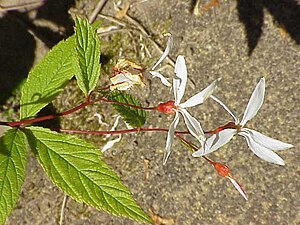Gillenia
| Gillenia | ||||||||||||
|---|---|---|---|---|---|---|---|---|---|---|---|---|

Northern trefoil ( Gillenia trifoliata ) |
||||||||||||
| Systematics | ||||||||||||
|
||||||||||||
| Scientific name | ||||||||||||
| Gillenia | ||||||||||||
| Monk |
The Gillenia are a plant kind from the family of the rose family (Rosaceae).
description
Gillenia are perennial herbaceous plants . Their leaves are alternate, triple pinnate and short-stalked, the individual leaflets have incised edges. Stipules are both large and small.
The inflorescence is a terminal, umbrella grape- like or panicle-like composite cluster . The flowers are long-stalked and quite large. The flower cup is bell-shaped to tubular, an outer calyx is missing. The sepals lie on top of each other like scales, the petals are white to pale pink.
A discus is not visible, there are ten to twenty stamens . The five pistils are not grown and stand in front of the sepals. The two to four ovules are ingrown close to the base and apotropic.
The fruit is a follicle with knöchrigem pericarp , which soon bursts the flower cups during growth. The one to four seeds are relatively large. The number of chromosomes is 2n = 18.
distribution
Gillenia occurs in North America in Canada ( Ontario ) and the eastern United States in mountain forests .
Systematics
The genus was first described by Conrad Moench in 1802 . It is placed in the Supertribus Pyrodae of the subfamily Spiraeoideae without being assigned to a tribe . A synonym that is often used up to the present day is porteranthus . There are two types:
- Southern trefoil ( Gillenia stipulata (Muhl. Ex Willd.) Nutt. )
- Northern trefoil ( Gillenia trifoliata (L.) Moench )
Use as a medicinal plant
In North America, the plant is known under the name Bowman's Root ("root of the bowman") because it was used by the Indians as a medicine. It was used as a laxative, to cleanse the blood and to treat liver diseases. In addition, played a role in the spiritual cleansing rituals of the Indians, as it induces vomiting.
However, the medicinal effect has not been proven, so consumption should be avoided.
proof
- C. Kalkman: Rosaceae. In: Klaus Kubitzki (Ed.): The Families and Genera of Vascular Plants - Volume VI - Flowering Plants - Dicotyledons - Celastrales, Oxalidales, Rosales, Cornales, Ericales. Springer-Verlag, Berlin 2004, p. 359, ISBN 978-3-540-06512-8
Individual evidence
- ↑ Three-leaf sparrow (Gillenia) as a medicinal plant. Retrieved September 26, 2017 .